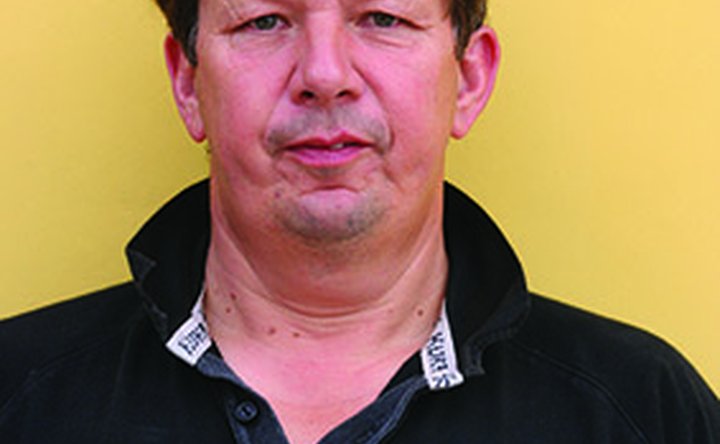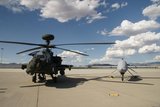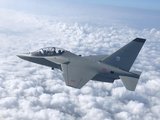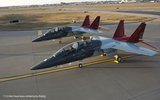History repeating at I/ITSEC 2022 Senior Leader Panel
The US Marine Corps has credited the NTSA with a major change in approach to how the service regards training. (Photo: USMC)
In introducing the Senior Leader Panel at this year’s I/ITSEC event in Orlando, National Training and Simulation Association (NTSA) president, RAdm (Ret) James Robb told delegates that this is ‘the highest-ranking senior leader panel that we have ever had at I/ITSEC’.
He gave a special welcome to Dr Dimitri Kusnezov, Under Secretary for Science and Technology at the Department of Homeland Security and the foreign member of the panel, Lt Gen Michael Claesson, Chief of Joint Operations for the Swedish Armed Forces.
Speaking first, Kusnezov perhaps hit a nail on the head with his rhetoric when he asked, ‘how do you prepare and train for things that are not experientially based?’ He made the point that as a scientist he has ‘the benefit of taking the long view’. And this view is not possible with the majority of military decision-making dictated by two-and-a-half year posting cycles that result in successive staff officers responsible for simulation who do not have sufficient time to ‘bed in’.
Related Articles
Congressional speakers highlight Chinese threat at I/ITSEC 2022
Fireside Chat forum speakers stress need for training acceleration at I/ITSEC 2022
This results in a failure to build on previous experience and the paucity of this experience is reflected in the use of buzz-word bingo phrases – ‘transformation’ is currently in a league of its own.
Lt Gen Kevin Iiams, Commanding General at Marine Corps Training and Education Command, paid the NTSA a major compliment when he said the organisation had driven training change in the corps.
It is no secret that the USMC had failed to make investments in training infrastructure over the years, but this is now beginning to change. ‘We are about to launch our Training and Education 2030 document which will set out our path for the future,’ Iiams told delegates.
‘We have progressed over recent years but need to do more,’ he said. The USMC has Project Tripoli under way that will ‘totally transform the way we train’. The corps has said that in its mature state Tripoli, ‘supports the commandant’s vision for Force Design 2030 by providing a comprehensive venue to train using emerging systems and capabilities across all domains. It will build readiness across all echelons of command and throughout the MAGTF [Marine Air-Ground Task Force] while allowing for experimentation with emerging technologies and concepts.’
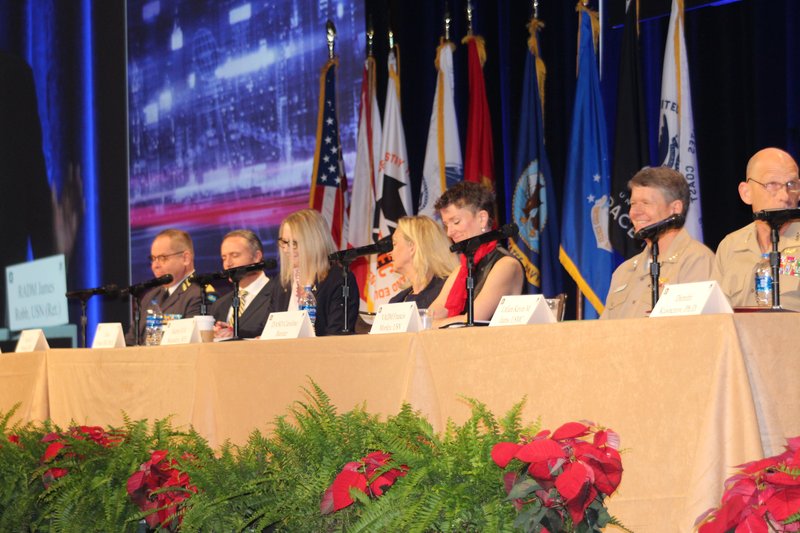
The NTSA described I/ITSEC 2022's Senior Leadership Panel as the most high-ranking ever. (Photo: author)
Although all US services have visions for the future of training, the USN's VAdm Francis Morley, Principal Military Deputy Assistant Secretary of the Navy (R&D and Acquisition) underscored the challenges of operating in the real world and in particular ‘changing threats, budget pressures, inflation and industrial workforce shortages'.
The latter, said Morley, ‘saw shortages of welders, electricians and other blue-collar specialists at the nation’s shipyards’. He added that the country has undervalued these specialists for a number of years ‘but there are lots of well paid, non-PhD, debt-free jobs out there’.
Another perspective was provided by Caroline Baxter, Deputy Assistant Secretary of Defense for Force, Education and Training. She told the audience that 2023 ‘is going to be the year of training but we are running out of time to reform and refresh military training,’ she said. ‘I’m frustrated by [training] systems that look the same as they did 20 years ago.’
‘It’s not enough to have the best equipment if we can’t use it,’ she explained, ‘and that is why the DoD is looking to create a three-star joint forces S&T group in the next couple of months to drive this forward.’
At the core of this approach to simulation is the Joint Force Training Infrastructure (JOTI) initiative. Whether this document is just words or a credible call to action is yet to be seen.
‘It’s not enough to have the best equipment if we can’t use it, and that is why the DoD is looking to create a three-star joint forces S&T group in the next couple of months to drive this forward.’— Caroline Baxter, Deputy Assistant Secretary of Defense for Force, Education and Training
For his part, Claesson made some important points about current threats and highlighted Russia as an example. ‘We didn’t wake up in 2008 when they invaded Georgia or later, in Crimea in 2014 but now we can see the threat,’ he said. ‘That threat is magnified when we consider Syria and what the Wagner Group is doing around the world.’
In response, he said that Sweden was expanding its defence forces and focusing on joint force operations. He also made the point that logistics are vital in war, and the question should be asked if there is the manpower, equipment and ammunition for any future conflict.
The key takeaways from the Senior Leader Panel were the need for closer integration with allies and industry, common standards leading to interoperable simulators, and the growing threats faced by the West.
Shephard's I/ITSEC 2022 coverage is sponsored by:

More from I/ITSEC 2022 Show Portal
-
![I/ITSEC 2022: HII enhances human-machine teaming training for US Army]()
I/ITSEC 2022: HII enhances human-machine teaming training for US Army
HII’s crewed-uncrewed teaming training system has been tested with the US Army’s Apache, but it can operate with any autonomous system with the right equipment to receive data.
-
![All the news from I/ITSEC and talking seabed warfare]()
All the news from I/ITSEC and talking seabed warfare
The Shephard Media news team looks at all the developments in the military training and simulation world, and discovers the trends and challenges in seabed warfare.
-
![Leonardo explores 6th-generation combat aircraft simulation at I/ITSEC 2022]()
Leonardo explores 6th-generation combat aircraft simulation at I/ITSEC 2022
Leonardo is developing the Smart Chair system in its Battle Lab that allows for advanced pilot training for multi-domain scenarios and can potentially 'replicate a sixth-generation fighter jet cockpit'.
-
![I/ITSEC 2022: Red Hawk jet trainer to be digital platform from day one]()
I/ITSEC 2022: Red Hawk jet trainer to be digital platform from day one
Boeing's T-7A Red Hawk simulator and maintenance training system will allow pilots and ground crew to train in novel ways as soon as the platforms are delivered.
-
![I/ITSEC 2022: Saab stays focused and committed to multi-site training delivery]()
I/ITSEC 2022: Saab stays focused and committed to multi-site training delivery
Saab has increased training activities across core markets, opened combined training centres and is set to grow its business further.
-
![I/ITSEC 2022: CAE to create ‘data ecosystem’ in synthetic environment and rethink approach to innovation]()
I/ITSEC 2022: CAE to create ‘data ecosystem’ in synthetic environment and rethink approach to innovation
CAE believes the future of training technologies will be fundamentally driven by bringing different industries together and no single company can exist in a vacuum - an approach that defence should adopt too.









